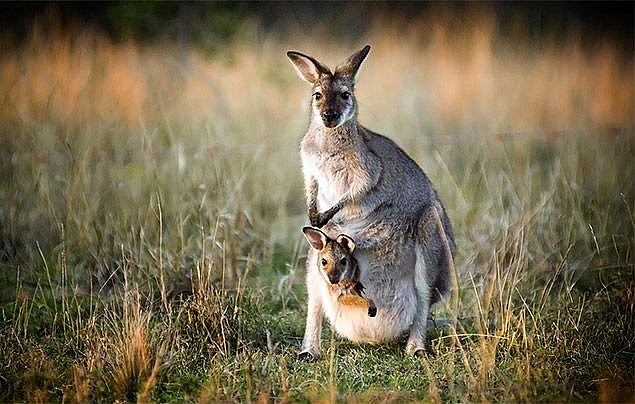Why Can Kangaroos Jump Non-Stop Without Feeling Tired?
 |
| Why Can Kangaroos Jump Non-Stop Without Feeling Tired? Photo natgeokids |
| Contents |
The kangaroo is the marsupial that gets the most attention. It's possible that you're familiar with this exceptionally rare species due to the fact that it's come to symbolize Australia, which is where it's native. They do this in the front pouches of their body, which are quite tiny.
Kangaroos, which spend the most of their lives on grasslands, have discovered that playing hopscotch is a more effective use of their energy than running.
How do Kangaroos move?
Aboriginal and Torres Strait Islander people all around Australia place a high spiritual and cultural value on kangaroos. Ancient rock drawings, some of which are tens of thousands of years old, frequently include the kangaroo. The Guuga Yimithirr people of north-eastern Queensland gave the eastern grey kangaroo the name 'gangurru,' from whence we get the word 'kangaroo.
Kangaroos move using their two forelimbs, two hind-limbs, and tail. Hopping kangaroos use their two muscular hind-limbs and tail, whereas grazing animals move using their forelimbs, hindlimbs, and tail.
READ MORE: Amazing Facts About The Slowest Animals In The World
| Kangaroos can not really walk, but they do not always obviously hop when they are moving. You can see them slowly moving when they are grazing on open grasslands. This is called crawl-walking. We’ll look into their slow-moving procedure in a minute. You will most likely see a hopping kangaroo when they see you! Kangaroos are shy animals and flee when they see potential predators (like you and me). |
Kangaroos can't move backwardsBecause of their long feet and large tail, kangaroos can’t walk or hop backwards. This is one of the reasons the kangaroo appears on the Australian Coat of Arms, representing a nation that is always moving forward. |
How high can kangaroos jump?
 |
| A male Red kangaroo can jump up to 3 meters in the air. Photo science |
According to Wiki (Red kangaroo) a male Red kangaroo can jump up to 3 meters in the air (around 10 ft).
They have the limb length, tendon strength, and tail stiffness necessary for great heights in jumping. Their energy-efficient gate is fascinating; it works like a rubber band, recharging the jumper's tendons after each landing. A kangaroo's ability to traverse great distances with minimum expenditure of energy is due in significant part to its ability to generate energy for breathing.
READ MORE: Facts About 10 Animals That Can Change Colors
How fast can Kangaroos run?
 |
| They are capable of speeds of up to 70 kmph. Photo Kangaroo fact |
You need a lot of speed to reach a good height and length while long jumping, as anyone who has tried it will attest. The same is true for kangaroos, who can gain far more height and distance from a running jump than they do from a standing one.
The kangaroo can hop at speeds of up to 30 kilometers per hour (19 miles per hour). But they may travel as fast as 70 kph (44 m/h).
Up to 2 kilometers (about 1 mile and a half), kangaroos can maintain speeds of up to 40 kilometers per hour (24 miles per hour), but at greater speeds, they are unable to maintain such endurance. Over time, they'll wear down if they keep moving at a rapid clip, so they have to keep things somewhat steady.
How kangaroos move at slow speeds (crawl-walking)Kangaroos lean forward Their body weight is supported by their forelimbs and hind limbs They tense their tail which touches the ground Kangaroos then raise their hind limbs - their body weight is then supported by their forelimbs and tail. Their body forms a tripod. They then pull their hind limbs slightly forward They move their hind limbs back on the ground Kangaroos then raise their forelimbs and move them forward if they continue to walk while their hind limbs and tail touch the ground |
How long can Kangaroos jump?
With each of its standing leaps, a kangaroo can cover a distance of 2 meters (6 feet, 6 inches). This means they are unable to gain any beneficial momentum prior to jumping, limiting the height to which they may go. However, on level terrain with no impediments, a single jump may travel 9 meters while running from a predator (almost 30 feet).
| Hopping supports kangaroos' breathing Kangaroos have even more benefits when they hop instead of walk. They not only require relatively little energy to hop around but hopping actively supports their breathing. If you watch their bouncing movements closely, you can see their gut moving up and down. This inflates and deflates their lungs which makes them extremely energy efficient. In sum, we can say that kangaroos do everything to get from point A to point B as efficiently as possible. |
Does Kangaroo use a lot of energy when jumping continuously?
 |
| The lower body of the kangaroo is very different from that of other animals. Photo natgeokids |
Although it appears to take a lot of work, the kangaroo's preferred method of transport really uses less energy than running or walking. Kangaroos have poor walking abilities, and while moving slowly, they utilize their tail and front legs like a tripod to support their weight. When this happens, it gives the impression that they are actually crawling.
The kangaroo's legs are unlike those of any other mammal. It's true that kangaroos' predecessors also hopped around on two feet. They age and lose some muscle and ligament tissue while gaining new ones.
Unfortunately, unlike most other animals that sprint, modern kangaroos lack the developed gluteal muscles that help propel them forward. However, dropping them helps build stronger thighs. Another fascinating adaptation that these creatures have made is the development of strong, muscular tails.
Studies have shown that kangaroos may utilize their powerful tails as a fifth limb. The majority of the jump's muscular energy comes from the animal's tail, which functions like a spring. Because of this, these animals may gain speeds of up to 35 miles per hour with a single jump.
It would seem that climbing and descending the Australian landscape would be an inefficient use of energy, yet this type of movement is really highly efficient. The kangaroo's flat field habitat reduces the frequency and severity of its requirement for vertical movement. They consume up a lot of potential energy in their joints as they leap, much like the energy held in a stretched rubber band. That is, they are not using any energy, but rather releasing it.
They utilize their tails as springs, so they may save energy when they jump. In addition, their ability to leap around gives them an agility advantage. They are able to swiftly shift directions, almost like a spring, to avoid danger.
 Top 10 Animals With Shortest Lifespan On Earth Top 10 Animals With Shortest Lifespan On Earth Some animals have very short lifespan with only several days to a few months. Let’s explore Top 10 Animals With Shortest Lifespan On Earth. |
 Top 10 Animals With the Longest Lifespan on Earth Top 10 Animals With the Longest Lifespan on Earth Some birds, reptiles and marine animals have quite a long life span. They can live to 100-200 years old, even 500 years old. Read on ... |
 Top 20 Weirdest and Rarest Animals In The World - In Danger of Extinction Top 20 Weirdest and Rarest Animals In The World - In Danger of Extinction World of animals have lots of weird things. You might have never heard of animals in the list below as they are weirdest and rarest ... |
























